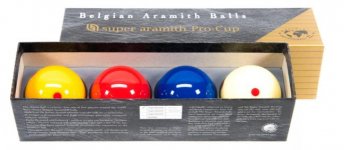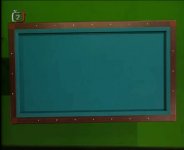Desítkový karambol (Czech version of the game)
Here the differences begin with a set of balls. To play the “tenfold cannon”, a set of four colorful balls is used - white, yellow (or white with a dot), red and blue:

They play Desítkový karambol on a small table of 7 feet and, unlike other cannons, the game is played in one cue ball (red). The position for the initial strike is also non-standard. The cue ball is set at the front mark, then blue is put at the back mark, on both sides of it on the back line the white sights (or white and yellow, depending on the set of balls) are closely placed, after which the blue moves to the middle mark of the table:

The game does not impose additional conditions in what order the aiming strike should be struck, except for the situation of the initial strike - here the cue ball must first touch the blue, and only then go to the white sighting. In some cases, especially in “bar” games, the initial hit is not performed; instead, a “scatter” of balls is carried out. Each player takes one white (or one white, another yellow), and one more of the remaining balls. Players stand in opposite corners of the table and, on command, send their balls to the center of the table with a moderate to very strong force (the force is negotiated in advance and both players try to direct the balls to the center at approximately the same speed). Balls are found approximately in the middle of the table and, after a collision, occupy a certain initial position:

Each player's goal is to score a pre-agreed amount of points (usually 200). Points are awarded for committing cannons, while the game continues in series. Cannons are evaluated according to the following rules:
1. If the cannon is made in any two aiming balls, then 1 point is awarded;
2. If the cannon is made in all three aiming balls, then 2 points are awarded;
3. If, before the first touch of the sighting cue ball touches the side, and then a cannon is made, then the points are doubled (that is, 10 points for a cannon in two balls, and 20 for a cannon in three balls). From this rule came the name of the game "tenfold cannon."
In the case when the cue ball touches one or several aiming balls before the next hit, the player has a choice:
• play cue ball in the direction from the touching balls so that the frozen sights do not start moving immediately after striking (it is allowed to return the cue ball to the frozen sights from the side or with the help of the mass);
• ask to restore the position for the initial strike.
If there is a cluster of several aiming balls on the table, in some variants of the rules the condition is additionally imposed that the cluster cannot be played directly. The hit must first fall into one of the balls in the cluster, while the remaining group of balls must not move, and after this condition is fulfilled, the cue ball can touch one or more balls in the remaining cluster. In this case, if the cluster consisted of three balls, and after a collision with the first sighting and its withdrawal from the cue ball group, it falls into only one of the two remaining stuck sighting, anyway the strike counts as a cannon committed in three balls. And if, between the first collision and the cue ball drive, the remainder of the cluster was hit on board, then the points accumulated will be increased 10 times. This rule is used quite rarely in a non-tournament format due to the difficulty of determining without video recording whether the remainder of the cluster was alarmed before hitting the cue ball. In addition, in some versions of the rules, it is assumed that if the cluster stands in such a way that the blow cannot be delivered in any way so as not to disturb the entire cluster at the first touch, this is voiced, and if both players have no objections, the position is restored for an initial strike.
The game provides the same fouls as in other variants of cannon games, the result of their completion is the transition to the opponent. An exception is the departure of any ball outside the playing field. In this case, the player who committed a foul is additionally fined 5 points, which are deducted from the amount he has previously accumulated. In this case, the sum of points cannot fall below zero.
Some editions of the rules additionally impose conditions for an “honest” completion of the game:
• the player must make the last hit with the cue ball touching the side (not necessarily before touching the first sighting, but surely the second if the cannon is made in two balls, or the third if the cannon is made in three balls). If this condition is not met, the points for the strike are not awarded, and the right to strike passes to the opponent;
• or the player must score exactly as many points as a blow as he needs to complete the game. In the event that more points are scored than is required, the sum of points by which the player “went over” is subtracted from the maximum in the game, and the move goes to the opponent. For example, the game is played up to 200 points, and the player currently has 197 points, and he makes a cannon two balls from the side (that is, scores 10 points), then the total amount of points he has is 207, which is 7 points higher than the maximum games, and these 7 points are deducted from the maximum allowed, that is, the player has 193 points (200 - 7).
Karambol (Polish version of the game)
Although this game can hardly be called four-ball, it fits this part best. For the game, a Czech set of balls or, rather, four sets is used (well, I did not find stock options for one set made to order). You can play together, three or a multiple of the participants divided into teams.
The game is a billiard adaptation of throwing games with balls, including Bocce , Petanque (Pétanque) and Bowles (Bowls) , and is quite different from other billiard games by the absence of a cue - punches are replaced by throw-rolls of balls from a hand.
The game uses one aiming (blue) ball, called bulin, as well as four cues of the same color in the "store" for each player or team (red for the first player, white for the second player and yellow for the third).
When the game starts, blue randomly rolls on the table so that it occupies the far half of the table (if blue after rolling remains in the near half, then another player rolls it again). Then the first player approaches the table and performs a swing towards the blue ball from the zone of the house. The goal is to put the cue ball as close to the blue ball as possible. A prerequisite is to hit the cue ball in at least two sides before stopping the cue ball or touching any of the balls on the table.
The game provides fouls in cases where:
• two sides were not touched during the throw - the ball is removed from the table in the “vault" to the player, he is penalized for 1 point if one side was touched or 2 points if there were no side touches;
• the ball was in the hand at the moment of rolling and crossed the line of the house - the ball is removed in the “vault", a penalty of 2 points;
• the ball flew out of the playing field (including a ride on board) - the ball is removed in the "vault", the player is fined 2 points;
• someone intentionally or accidentally commits a carcass of balls located on the playing field (except for his cue ball in the “house” during rolling and when removing the ball when returning to the “vault”) - a penalty of 3 points to the player or team who committed a foul.
After throwing the first player, the second player approaches the table and does the same - he tries to roll the cue ball as close as possible through two sides to the blue. It is allowed at the same time to get into one’s or another’s cue ball, already entered into the game, thereby allowing not only to bring their cue ball closer, but also to push the opponent’s cue ball away from the aiming blue ball. As soon as there are two (three in the case of a three-player game) and more cues of any color on the table, the sequence is determined according to the following rule - if after the last throw the cue ball closest to the blue ball differs in color from the player’s cue ball, then this player (or his team ) makes another throw, otherwise the right of the throw passes to the next player / team in order. If the game is played as a team, then within the framework of one team, the order of the throw is determined by the carousel principle - the next roll of a cue ball of a certain color is made by the player who goes in order after the last thrower of a cue ball of this color (or the first one on the list if there were no rolls of a cue ball of a given color in the game) . The definition of the player / team starting the second and further games is also determined by the carousel - the player or the team starts in the game, following the player / team that started the last game in order.
If, according to the rule above, a player / team must make a throw, there are no balls left in the "vault" (they are all on the playing field), the transition to the player / team proceeds automatically, following in turn.
As soon as all players / teams run out of balls in the "vault", that is, all the cue-balls are on the playing field, they proceed to scoring. To do this, select the four balls closest to the blue. Each selected ball, related in color to the player / team, brings her 1 point. An exception is the situation if all four selected balls belong to one player / team, in which case he / they get 8 points. That is, for one batch, you can get 0, 1, 2, 3 or 8 points. The points received are added to the player / team account, and penalty points, if any, are deducted from the account. After that, it is checked whether a certain player or team has reached a predetermined number of points (usually 21) and, if so, then this player / team is recognized as the winner. If after the game several teams scored the minimum necessary for victory, the one that scored the most points wins. If the score is equal, then between the teams contesting leadership, an additional game is played.
Video
https://www.youtube.com/watch?v=ysszCBkk93I
German game of saupartie, identical to Czech rules
Dutch four-ball rules (honderden)


